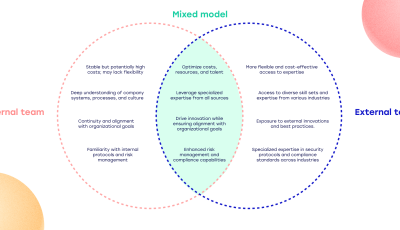AI has the potential to help businesses improve efficiency and unlock new market opportunities. However, AI software development projects can be expensive and time-consuming, which makes risk mitigation crucial for their success.
In the article, I will share our experiences navigating common pitfalls in AI projects at Helmes.
Our data & analytics business unit currently has a team of 30 employees. We have successfully completed AI software development projects across various industries over the last four years, from the automotive sector to e-commerce and healthcare. For instance, our past and ongoing projects encompass a range of AI applications:
- Building a country-wide crime prediction grid for the Lithuanian National Police based on data from public registries
- Creating a search interface to help recruiters find the best talents for their vacancies among 600 million profiles worldwide
- Building an analytical cloud platform for vehicle performance and maintenance based on automotive data
- Providing data engineering and AI services for network optimization to telecom companies
- Customer profile analysis, sales prediction, and pricing optimization for e-commerce players
- Leveraging machine learning for data analysis and reporting in the healthcare domain.
In our experience, organizations are turning to AI for two main reasons. Most turn to AI for optimization and improved efficiency, particularly since technological advances (for instance, handwriting recognition or natural language parsing) now make it possible to automate processes that, until recently, could not be digitized.
For a smaller group of our clients, the primary goal is unlocking new business opportunities. These organizations have access to large amounts of data and seek ways to utilize it to unlock new services and revenue streams (although they may simultaneously use AI for optimization in other contexts, such as production lines).
Yet AI software development projects are very different from most IT projects. While in a typical IT development project, the result is more or less clear (we know we can build a mobile app and what the result will look like), with AI, we are entering unchartered areas of implementing the technology. In other words, there is no guarantee that the research will yield the results that we are hoping for.
For this reason, at Helmes Group, we start AI software development projects with an AI audit and feasibility study that will help us mitigate the risk of the project ultimately not delivering business value.
We can skip the audit in cases where the client already has data scientists or engineers on board and is looking strictly for expertise for the actual implementation of AI.
What is an AI audit/feasibility study?
In the AI audit, we identify the organization’s challenges and outline potential solutions based on intelligent engineering, such as process automation and machine learning – all forms of AI. We look at the sections of the business where AI could be applied and suggest proven solutions leveraging our expertise in digital transformation, scalable engineering, and building AI models.
Next, we assess the IT infrastructure, including whether there is enough data to implement the proposed solution. We also evaluate the organizational readiness for digital transformation and determine the project’s financial viability.
As part of the audit, we look into off-the-shelf solutions that may apply since many problems don’t require custom AI development but can be solved with an existing service on the market. (For instance, for sales prediction, we could use tools based on statistical prediction models that will immediately start delivering value.)
If no off-the-shelf product exists and custom AI development is needed, we evaluate if we can build the solution within the estimated time and budget.
The audit could be viewed as the business analysis part of an AI development project. It will allow us to discover any risks to the project before a single line of code gets written.
Common obstacles to AI implementation
An AI project may turn out to be too risky for many reasons. The most common obstacles that we have observed include:
- No (access to) data – This is possibly the most obvious obstruction, as machine learning requires data. Even if a problem is solvable from a technical standpoint, having no access to high-quality data would still doom the project.
- Organizational factors – The efficient implementation of AI depends on the digitalization of many business processes, which requires a fundamental organizational transformation. If not all stakeholders believe in the project, such a transformation is unlikely to happen.
- Excessive cost – Even if technically feasible, the project may turn out to be too costly (for instance, an optimization saving the company 300,000 euros a year would require an investment of several billion). In the audit, we also evaluate post-deployment support needs so they can be factored into the calculations.
Full spectrum of AI expertise
Helmes offers clients machine learning, AI model building, and infrastructure and data management services.
With more than 15 years of experience in data engineering, we build data platforms that allow organizations to continue their AI journey and build machine learning models on top of them. Data management is crucial in AI projects as the vast amounts of data require building an IT infrastructure that streams data and does partial slicing of data to allow for continuous retraining of models.
Though our expertise lies in AI applications, we collaborate with research institutions conducting foundational research into AI. We also work with a network of AI partners, so we can temporarily ramp up our data science capabilities for projects if needed.
The technologies we use include:
- Programming languages: Python, Java
- Real-time data ingestion: Kafka, Amazon SNS, Azure Event Grid
- Foundational models: LLaMA, ChatGPT
- Machine-learning frameworks: Pandas DataFrame, Scikit-learn, TensorFlow
How to successfully implement AI?
If you plan to undertake an AI project, here are three pieces of advice rooted in our team’s experience.
1. Start small and validate the business value
Identify the low-hanging fruits and start the AI journey in your organization with small projects. These could be domain-centric projects that leverage existing data (for instance, sales prediction, customer segmentation in e-commerce, or image analysis and data summarizing in healthcare).
You can think big in terms of features but still keep the scope small. Instead of focusing country-wide, limit yourself to one city and scale it up from there. Instead of looking at all the factors, initially test with one, then with three parameters to verify if the solution delivers the value that you expected.
Starting a large project only to scrap it midway will actually retard the adoption of AI in your organization instead of driving it.
2. Contribute the domain expertise
A key factor for the success of an AI project, particularly when building new models, is involving the necessary domain knowledge. A technical partner like Helmes can provide the technical know-how for the project but does not have domain experts, such as medical doctors or automotive engineers, on their team.
Therefore, domain expertise must come from the client who, after all, knows their business best. A technical partner can build an AI model, but input from domain experts is needed to help train the AI and assess the results.
3. Manage expectations
The recent hype may easily create an impression that AI is all-powerful, but that is not the case. AI is not a silver bullet that will magically solve every problem; it comes with its own limitations. (For example, despite having a translator component, most large language models like ChatGPT are currently trained mainly on English-language texts.)
Any code in production can break, and so can the value of AI. In addition, AI models need to be continuously retrained to avoid a common problem called data drift. It would thus be a mistake to assume that you can deploy an AI project once and be hands-off after that. Instead, an AI project is a continuous process that involves constant monitoring and retraining.
Work with Helmes
Adopting AI software will give organizations a competitive advantage by allowing them to operate more efficiently and scale faster. Whether it’s today or in five years, I believe we will all ultimately need to implement AI to stay in business.
Learn more about us, if you’d like to learn more about our experience in data engineering, machine learning, and automation projects or discuss how to implement AI software in your business.
Get in touch




